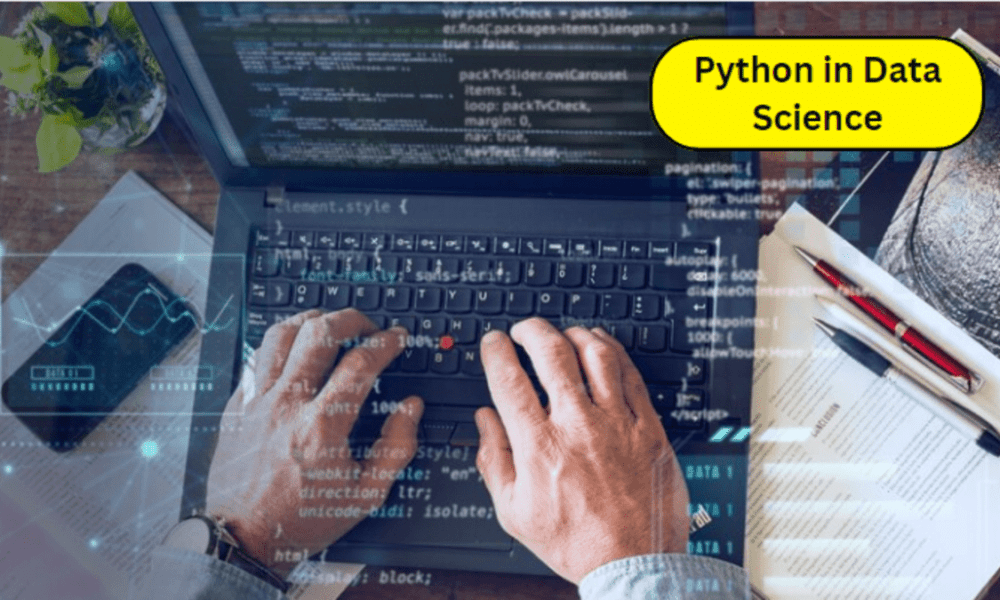Python in Data Science is a crucial field for companies and academics due to its flexibility and power. Python is the preferred programming language for data scientists due to its essential libraries and tools. This post explores Python’s applications in data science and their usefulness for analysts and data scientists.
Let’s define data science.
Data science is a multidisciplinary field that utilizes scientific methods, algorithms, processes, and systems to extract knowledge and insights from structured and unstructured data. To find hidden patterns and trends, it integrates many computer science, statistics, and domain knowledge facets.
The Role of Python in Data Science
Python’s ease of use, adaptability, and extensive library ecosystem make it a popular choice for data science programming in various crucial domains.
Data Collection and Cleaning
Before analyzing any data, it needs to be collected and cleaned. Python offers various libraries and tools like Pandas, NumPy, and Beautiful Soup that simplify data collection from diverse sources and the cleaning process.
Data Interpretation and Analysis
For data visualization, Python offers robust packages like Matplotlib, Seaborn, and Plotly. With the help of these libraries, data scientists may produce visually appealing dashboards, graphs, and charts that facilitate data interpretation and presentation.
Machine Learning
Machine learning is a fundamental aspect of data science, and Python libraries like Tensor Flow and Scikit-Learn enable the creation, training, and evaluation of various machine learning strategies.
Deep Learning
For more complex tasks like natural language processing and computer vision, Python’s libraries like Keras and PyTorch are popular choices. These libraries allow data scientists to implement deep learning models effectively.
Key Python Libraries for Data Science
To harness the full potential of Python in data science, several libraries and tools are at your disposal:
Pandas
Pandas is a powerful library for data manipulation and analysis. It provides data structures like Data Frames and Series, making it easy to explore and clean datasets.
NumPy
NumPy is essential for numerical and mathematical operations. It offers support for arrays, linear algebra, and random number generation.
Matplotlib
Matplotlib is a versatile library for creating static, animated, or interactive visualizations. It’s particularly handy for plotting graphs.
Scikit-Learn
Scikit-Learn is a comprehensive library for machine learning. It includes tools for classification, regression, clustering, dimensionality reduction, and more.
TensorFlow
Google is the creator of the popular deep learning framework TensorFlow. It enables neural network training and development for a range of applications.
The Python Environment for Data Science
Python also provides an integrated environment for data science work, with the popular options being:
Jupyter Notebook
Data scientists may create and share documents with live code, equations, graphics, and narrative prose using the interactive and user-friendly Jupyter Notebook platform.
Anaconda
Anaconda is a distribution that comes with a package manager, environment manager, and a vast collection of libraries, making it a convenient choice for data scientists.
Challenges and Future Trends
Python’s widespread use in data science faces challenges like managing large datasets and ensuring model interpretability. Despite these, Python’s continuous evolution and community efforts to address these issues ensure its continued relevance in data science.
Conclusion
Python is a crucial data science tool, enabling deep learning and machine learning models, data collection, analysis, and visualization. Its large library ecology and user-friendly interface make it a top choice for specialists.
FAQs
Why is Python the preferred language for data science?
Because of its huge library ecosystem, ease of use, and versatility, Python is the language of choice in data science. These factors make data manipulation, analysis, and modeling more easy.
Which libraries are essential for data analysis in Python?
NumPy is a crucial library for numerical operations, Pandas is for data manipulation, and Matplotlib is for data visualization when it comes to data analysis in Python.
What constitutes data science’s fundamental elements?
The fundamental elements of data science include machine learning, deep learning, data cleansing and analysis, and data acquisition.
How does Python handle challenges like handling large datasets?
Python addresses challenges like handling large datasets through libraries like Dask and by utilizing distributed computing frameworks.
How will Python do in the field of data science?
With ongoing development and a burgeoning community that consistently improves its capabilities and takes on new problems, Python’s future in data science is still bright.
Read More: Techburneh.com










